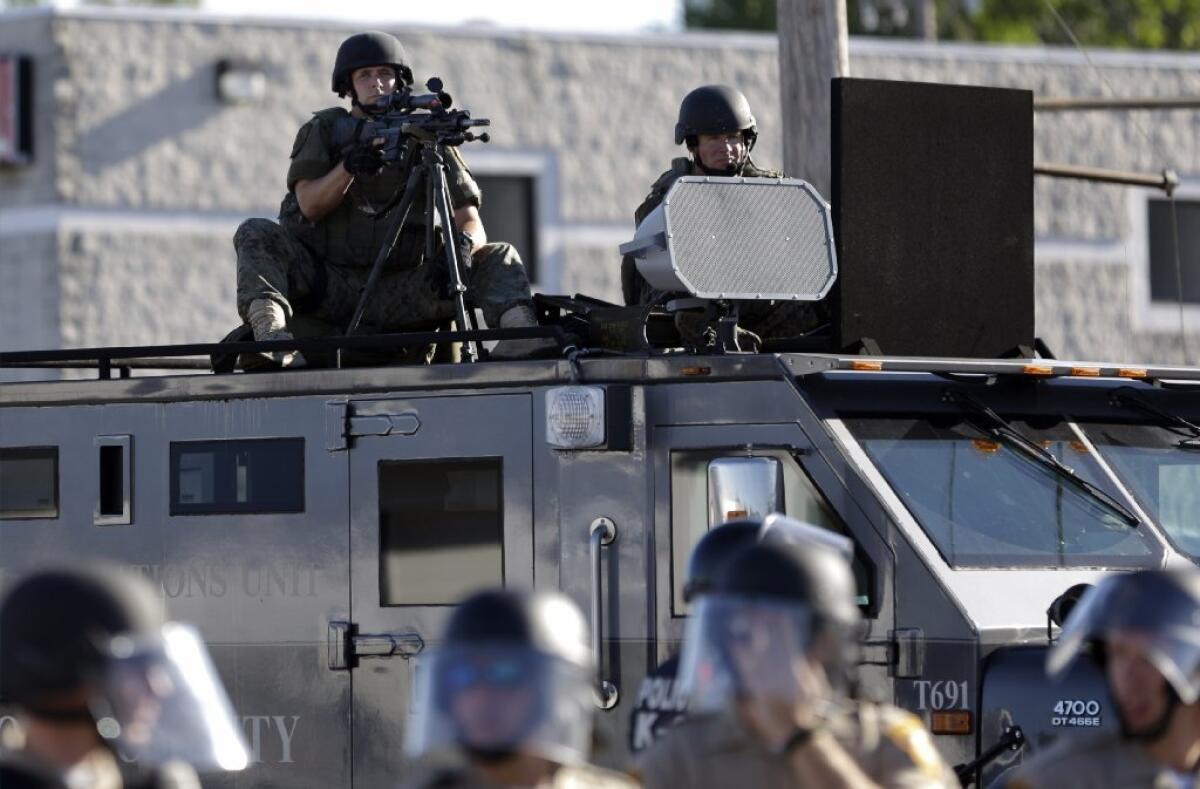Editorial: Police departments should reduce their military supplies

Among the more jarring images to come out of the Ferguson fiasco were the photos of local police officers clad in military helmets, camouflage uniforms and other combat-style gear arrayed on the street in military formation, carrying M4 carbine assault rifles and backed up by an armored personnel carrier. As one critic put it, some American troops in Afghanistan weren’t as well-supplied as the cops in Ferguson, Mo.
That materiel didn’t materialize overnight. The militarization of Ferguson’s police is part of a broader evolution in American policing that has been propelled in part by federal programs that offer hand-me-down military equipment to local departments, usually for free, as well as price discounts on new gear. In fact, weeks before Officer Darren Wilson shot and killed Michael Brown in August, the American Civil Liberties Union issued a scathing report on the militarization of police forces around the country, with a focus on the excessive use of paramilitary SWAT teams to serve search warrants for minor drug crimes — scenarios that have, predictably enough, led to tragedy.
Several weeks after the Ferguson shooting, President Obama asked for a report on the federal programs that have moved billions of dollars worth of surplus military equipment into the hands of local police agencies. Most of the equipment is innocuous, such as Department of Defense office furniture and computers. But under the Defense Department’s 1033 Program alone, which was created in 1997, the feds have also passed along 460,000 “controlled” items such as military-grade weapons (including, believe it or not, grenade launchers, three of which found a home for a time with the L.A. Unified School District’s police department), mine-resistant armored vehicles and aircraft. Often, the recipients regift the equipment to other agencies, as when Burbank two years ago was given a new armored vehicle and sold its old one to South Pasadena for a dollar.
Last week, Obama issued a presidential directive that makes some sensible and overdue changes in these programs. He didn’t propose ending the transfers, but he will require more specialized training for local police receiving the military-grade gear, covering not just how to use the equipment, but also when and where it is appropriate to use it. Obama also ordered the federal government to draft a list of equipment “allowable for acquisition … and ensure that all equipment on the list has a legitimate civilian law enforcement purpose.”
Most importantly, the president has taken the decision on whether to apply for military surplus equipment out of the hands of police chiefs and given it to local civilian authorities such as city councils or, in the case of Los Angeles, the civilian Police Commission. Under the current system, some local councils around the country have been surprised when armored vehicles have been added to their police departments without their knowledge. If a community is going to have a militarized police force, that should at least be a conscious choice by the community, not the realized dream of a police chief offered a set of new war-fighting toys.
The big question is why some of this equipment would ever be considered appropriate for local use. Why does a school district police department need a grenade launcher? Why does Orange County’s Saddleback College police force need a $733,000 mine-resistant armored vehicle? Why do police in the Central Valley city of Wheatland, population 2,300, need five M16A rifles? Police work is often dangerous, but this level of militarization seems extreme and may even exacerbate the danger by giving rise to a warrior mentality. Certainly, police turned out in military gear can have the feel of an occupying army; in Ferguson, the mere presence of military-looking troops fanned the flames of discontent. Besides, states have access to National Guard units they can deploy when circumstances call for a military response.
Shortly after a grand jury in Staten Island, New York, declined last week to indict the police officer accused of choking Eric Garner to death, Obama spoke of the need to bridge the dangerous divide between police and the communities they serve. He spoke, too, of the need to build civilian trust in law enforcement. Reducing the military profile of local police would be a good place to start.
Follow the Opinion section on Twitter @latimesopinion
More to Read
A cure for the common opinion
Get thought-provoking perspectives with our weekly newsletter.
You may occasionally receive promotional content from the Los Angeles Times.






